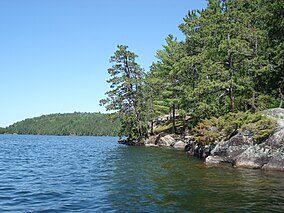Quetico Provincial Park
| Quetico Provincial Park | |
|---|---|
|
IUCN category II (national park)
|
|
 |
|
| Nearest city | Atikokan |
| Coordinates | 48°23′47″N 91°32′7″W / 48.39639°N 91.53528°WCoordinates: 48°23′47″N 91°32′7″W / 48.39639°N 91.53528°W |
| Area | 4,760 km2 (1,840 sq mi) |
| Established | 1913 (1909 as Quetico Forest Preserve) |
| Governing body | Ontario Parks |
Quetico Provincial Park is a large wilderness park in Northwestern Ontario, Canada, renowned for its excellent canoeing and fishing. This 4,760 km2 (1,180,000-acre) park shares its southern border with Minnesota's Boundary Waters Canoe Area Wilderness, which is part of the larger Superior National Forest. These large wilderness parks are often collectively referred to as the Boundary Waters or the Quetico-Superior Country.
The park includes over 2000 unofficial, unimproved wilderness campsites spread throughout more than 600 lakes. Canoeists require permit reservations and in-season may only enter the Quetico via six Ranger Stations which serve 21 specific entry points. It is possible to drive to three of these Ranger Stations: Dawson Trail, Atikokan, Lac La Croix. One must portage and paddle to Beaverhouse, and paddle or take a tow from an outfitter to Cache Bay or Prairie Portage. Drive-in camping is available only at the Dawson Trail campground; log cabins are also available to rent.
Most of the southern half of the Park is a region known historically as "Hunter Island" (not a real island).
In 1909, an "Order in Council" by the Government of Ontario established the Quetico Forest Reserve. Early the same year, the United States federal government established the adjacent Superior National Forest and Superior Game Refuge, which eventually would become the Boundary Waters Canoe Area Wilderness. Quetico Provincial Park was created in 1913 through passage of the Provincial Parks Act, although road access wasn't built until 1954.
The creation of the park created a conflict with the Lac La Croix First Nation who had a reserve located within the park. In 1915, the province cancelled the band's right to the reserve and relocated the people on the reserve. The grievances of the band were not addressed until 1991 when the Minister of Natural Resources, Bud Wildman, made an apology in the legislature for the move. Wildman also addressed one of the band's request to allow mechanized boats in the park for the purposes of guiding.
...
Wikipedia

